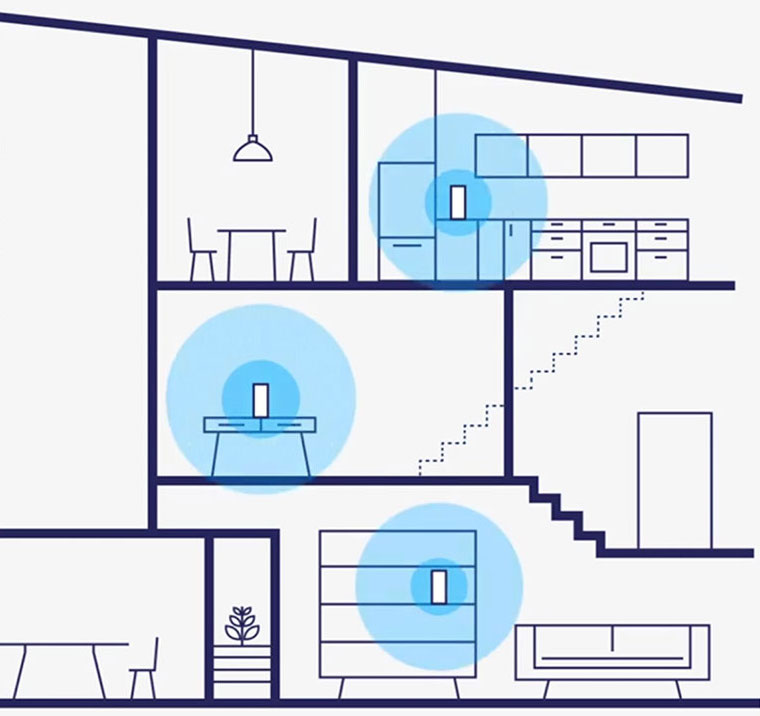
Canadians need a reliable, robust, and fast home network and mesh networks are the solution. Staying connected is more crucial than ever before. With the rise of smart homes and the increasing demand for seamless online connectivity, traditional Wi-Fi systems using a central home router are struggling to keep up. Read on to learn what mesh networks are, how they work, and why they might just be the future of home Wi-Fi for you.
What is a mesh network and how does it work?

A mesh network is a group of devices that act as a single Wi-Fi network; each device (known as a node) communicates with the others to create a strong and broad network. Unlike traditional routers, which communicate with devices directly, mesh networks rely on multiple nodes. If one fails, others can fill in, ensuring your Wi-Fi network remains stable.
In a mesh network, the nodes work together to distribute Wi-Fi signals evenly throughout your home. This system eliminates “dead zones” by providing the same level of internet access no matter where you are in your house.
Benefits of mesh networking for larger spaces
Mesh networks provide numerous benefits, especially for larger spaces. They offer improved coverage, faster internet speed, and more reliable connectivity. Unlike traditional routers, which diminish in strength the farther you are, mesh nodes distribute the signal evenly, regardless of your proximity to the primary router.
Additionally, they support multiple devices simultaneously, which is ideal for smart homes. They’re also scalable; you can add more nodes as needed.
What do I need to set up a mesh network?
Setting up a mesh network requires at least two or three nodes: one that connects to your modem and acts as the primary router, while the others act as satellites or extenders. For medium spaces, two nodes might suffice; however, larger areas or multiple floors likely require three or more to ensure complete coverage.
The number of nodes required will depend on various factors including the size of your space, the layout, and the building materials of your home. To find the right mesh network for your space, consider browsing Best Buy’s mesh network systems.
Can I just use any two routers and call it a mesh system?
While it might seem like a cost-effective shortcut, simply using two old routers does not create a true mesh system. Traditional routers are not designed to communicate with one another in the way that mesh network nodes do. They might extend the Wi-Fi coverage, but they won’t provide the same seamless connectivity, speed, or reliability that a dedicated mesh system offers.
You should also be aware that not all new routers are compatible with mesh networks. Mesh networks require specific technology and software that allow multiple nodes to communicate effectively with one another, creating a seamless and wide-reaching Wi-Fi network. While many newer router models are designed to function within a mesh system, there are still many that operate on the traditional single-point setup.
In a genuine mesh network, the nodes are designed to work together cohesively, creating a single, robust network that smartly manages your connectivity needs. Routers that are compatible with mesh networking are often sold as part of a mesh system, which includes multiple units to place around your space. These systems are specifically designed to work together seamlessly, whereas trying to combine non-mesh routers can result in network conflicts, reduced performance, and dead zones. When shopping for routers, it’s important to check the product specifications and features. Look for terms like “mesh network,” “mesh system,” “Wi-Fi system,” or “whole-home Wi-Fi” in the product description to determine compatibility. If you’re considering upgrading your home network with a mesh system, it’s advisable to purchase a complete system or add-on units that are guaranteed to work with your existing mesh-compatible router.
Setting up your first mesh network: Do’s and don’ts
When setting up your mesh network, there are several best practices to follow. First, place your primary node in a central location and the satellite nodes in areas where your Wi-Fi is typically weak. Don’t place nodes near electronics that might cause interference, like microwaves.
Do test the strength of your signal after setup to ensure there are no dead zones. Don’t forget to secure your network with a strong password.
How to manage your mesh network

Most mesh network systems come with their own management app. These apps allow you to monitor your network’s health, control which devices can access the internet, and provide parental controls. Regularly update your network’s firmware to ensure security and performance.
Managing your network also involves regular speed tests to ensure your ISP is providing the service you’re paying for. If you’re experiencing slower speeds, some apps offer diagnostics to help identify and resolve issues. Here are some additional tips for setting up and using a mesh network.
Mesh networks represent the next evolution in home Wi-Fi systems, offering unparalleled speed, coverage, and reliability. They’re especially beneficial for larger spaces and smart homes, ensuring every device stays connected. With careful setup and proper management, a mesh network can revolutionize your online experience.
This article was drafted using AI technology and then reviewed, fact-checked, and revised by a member of our editorial team.





